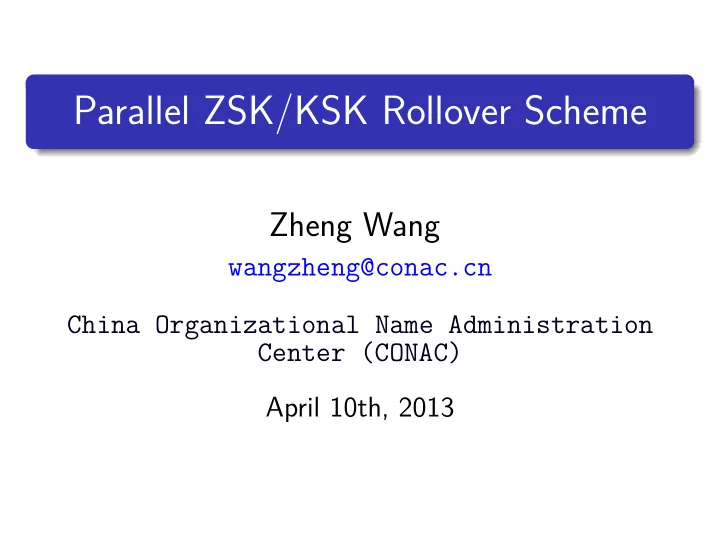

Parallel ZSK/KSK Rollover Scheme Zheng Wang wangzheng@conac.cn China Organizational Name Administration Center (CONAC) April 10th, 2013
Problem Solution Scheme Concluding Outline 1 The problem 2 The Solution 3 The Scheme 4 Concluding and Remarks Zheng Wang abbreviation of the title
Problem Solution Scheme Concluding The problem The separation of ZSK and KSK rollover Allow ZSK to rollover more frequently than KSK Believed to simplify the complicated and vulnerable key rollover operations Zheng Wang abbreviation of the title
Problem Solution Scheme Concluding The problem The separation of ZSK and KSK rollover Allow ZSK to rollover more frequently than KSK Believed to simplify the complicated and vulnerable key rollover operations Does it really help? Sequential ZSK and KSK rollover takes long time Help little in lowering operational complexity Zheng Wang abbreviation of the title
Problem Solution Scheme Concluding The problem The separation of ZSK and KSK rollover Allow ZSK to rollover more frequently than KSK Believed to simplify the complicated and vulnerable key rollover operations Does it really help? Sequential ZSK and KSK rollover takes long time Help little in lowering operational complexity Emergency rollover when both ZSK and KSK are compromised Speed is the top priority! Zheng Wang abbreviation of the title
Problem Solution Scheme Concluding 1 The problem 2 The Solution 3 The Scheme 4 Concluding and Remarks Zheng Wang abbreviation of the title
Problem Solution Scheme Concluding The Solution Parallel ZSK and KSK rollover Enable fast emergency ZSK and KSK rollover Employ similarities between ZSK and KSK rollover algorithms Zheng Wang abbreviation of the title
Problem Solution Scheme Concluding The Solution Parallel ZSK and KSK rollover Enable fast emergency ZSK and KSK rollover Employ similarities between ZSK and KSK rollover algorithms The advantage Avoid incurring significant complexity Minimize transition delays Zheng Wang abbreviation of the title
Problem Solution Scheme Concluding 1 The problem 2 The Solution 3 The Scheme 4 Concluding and Remarks Zheng Wang abbreviation of the title
Problem Solution Scheme Concluding The Scheme The time line At least one KSK and one ZSK are active before rollover starts Significant times and time intervals are marked act sub sgn prpC sig pub reg prpP pub rem rdy dea act Zheng Wang abbreviation of the title
Problem Solution Scheme Concluding Event 1 The successor ZSK and KSK are simultaneously published (Tpub) The successor ZSK and KSK are added to the DNSKEY RRset The new DNSKEY RRset is re-signed by both the current and successor KSK sub act sgn prpC sig pub reg prpP pub rdy dea act rem Zheng Wang abbreviation of the title
Problem Solution Scheme Concluding Event 2 The publication interval (Ipub) The successor ZSK waits for Ipub before signing the RRset The successor KSK waits for Ipub before submitting to the parent zone Ipub = DprpC + TTLkey (1) where DprpC is the propagation delay, TTLkey is the time-to-live (TTL) for the DNSKEY RRset The key’s ready time (Trdy) (2) Trdy = Tpub + Ipub Zheng Wang abbreviation of the title
Problem Solution Scheme Concluding Event 3 The successor ZSK starts being used to sign RRsets (Tact) The DS record corresponding to the new KSK is submitted to the parent zone for publication (Tsub) Tact and Tsub can take place simultaneously immediately after Trdy in a bid to minimize delay act sub sgn prpC sig pub reg prpP pub rdy dea act rem Zheng Wang abbreviation of the title
Problem Solution Scheme Concluding Event 4 For ZSK, all existing RRsets are re-signed and available in all slave servers (Tdea) (3) Tdea = Tact + Dsgn + DprpC where Dsgn is the delay needed to ensure that all existing RRsets have been re-signed with the new key, DprpC is the propagation delay For KSK, the DS record is published in the parent zone (KTact) (4) KTact = Tsub + Dreg + DprpP where Dreg is the registration delay, DprpP is the propagation delay for the DS record from the master of the parent zone to replicate to all slaves servers Zheng Wang abbreviation of the title
Problem Solution Scheme Concluding Event 5 After the RRSIG records created using the retired ZSK expire from all resolver caches, the retired ZSK can be removed from the zone’s DNSKEY RRset(ZTrem) ZTrem = Tdea + TTLsig (5) where TTLsig is the maximum TTL of all the RRSIG records in the zone created with the retired ZSK After any caches that contain a copy of the DS RRset have a copy containing the new DS record, the retired KSK is removed from the zone’s DNSKEY RRset (KTrem) KTrem = KTact + TTLds (6) where TTLds is the TTL of the DS record Zheng Wang abbreviation of the title
Problem Solution Scheme Concluding 1 The problem 2 The Solution 3 The Scheme 4 Concluding and Remarks Zheng Wang abbreviation of the title
Problem Solution Scheme Concluding Concluding and Remarks A parallel ZSK and KSK rollover scheme with short transition delay and low complexity is proposed This rollover delay can be approximated as DprpC + TTLkey + max { Dsgn + DprpC + TTLsig , Dreg + DprpP + TTLds } The scheme can be applied to the emergency ZSK and KSK rollover Zheng Wang abbreviation of the title
Thanks!
Recommend
More recommend